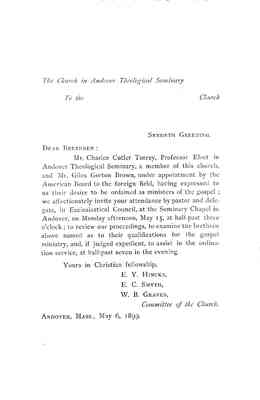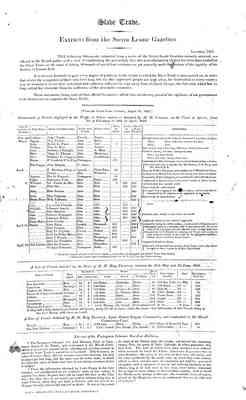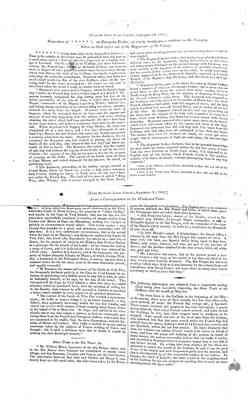Pages
page_0002
The Church in Andover Theological Seminary
To the Church
Sendeth Greeting
Dear Brethren:
Mr. Charles Cutler Torrey, Professor Elect in Andover Theological Seminary, a member of this church, and Mr. Giles Gorton Brown, under appointment by the American Board to the foreign field, have expressed to us their desire to be ordained as ministers of the gospel; we affectionately invite your attendance by pastor and delegate, in Ecclesiastical Council, at the Seminary Chapel in Andover, on Monday afternoon, May 15, at half-past three o'clock; to review our proceedings, to examine the brethren above named as to their qualifications for the gospel ministry, and, if judged expedient, to assist in the ordination service, at half-past seven in the evening.
Yours in Christian fellowship, E. Y. Hincks, E. C. Smyth W. B. Graves Committee of the Church Andover, Mass., May 6, 1899
page_0003
Slave Trade.
Extracts from the Sierra Leone Gazettes
LONDON, 1823. THE following statements, extracted from a series of the Sierra Leone Gazettes recently received, are offered to the British public with a view of establishing the melancholy fact, that notwithstanding all that has been done to abolish the Slave Trade on the coast of Africa, thousands of our fellow creatures are yet annually made the victims of the cupidity of the dealers of human flesh.
It is the deemed desirable to give every degree of publicity to the extent to which the Slave Trade is now carried on, in order that whilst the sympathies of those who have long felt for this oppressed people are kept alive, the benevolent in every country may be stimulated to use their individual and collective influence to wipe away from civilized Europe, the foul stain which has so long sullied her character from the sufferance of this detestable commerce.
These statements, being most of them official documents, afford also satisfactory proof of the vigilance of our government in its endeavors to suppress the Slave Trade.
page_0004
2 [From the Sierra Leone Gazette, September 14, 1822.]
Deposition of *****, an European Trader, of nearly twenty yearsresidence in this Country. Taken on Oath before one of the Magistrates of the Colony.
"*****, having been duly sworn, deposeth as follows:— That in the middle of Deember last, he proceeded from this port in a small sloop named "James" (his own property) on a trading voyage to Leeward. On his arrival at the Gallinas, saw three Schooners bearing the French flag; did not go to board of them, but went on shore to dispose of some goods: remained there for some days, during which time Siacca, the chief of the Gallinas, was busily employed in collecting the slaves for embarkation. Deponent states, that there is small island inside the Bar of the river Gallinas, where all the bartering trade for the slaves is carried on; the slaves are also sent to this island when the vessel is ready to receive them on board.
"Deponent next proceeded to Suggary, where he found a large ship * under the French flag, with a tender rigged as a Ketch+. Deponent instantly recognised the ship, having seen her five or six weeks previously, off the Isles de Loss, at which time Lieutenant Hagan, commander of his Majesty's gun-brig Thisrtle, boarded her, and having strong suspicions of her slave-trading intentions,instantly ordered her away from the islands. Deponent went on shore at Suggary, where he remained five or six days— saw the captain and surgeon of said ship bargaining with the natives, and every evening counting the slaves which had been purchased: the slaves were kept in two large houses, and under a temporary shed close by the waterside. When the deponent left Suggary for Cape Mount, the cargo was completed all to a few slaves, and a few days afterwards he saw, from Cape Mount, the said French ship under sail, beating out against a contrary wind from the shore. Deponent further declares, that he examined a Kroomen who had assisted in putting the slaves on board of said ship, who informed him that they had taken upwards of 300 on board. The Kroomen also stated, that the captain of said ship had ordered the captain of the ketch, to sail for the river Gaboon— the usrgeon of the ship having gone in her for the purpose of carrying on the traffic. The captain of the ketch came on shore at Cape Mount, and visited deponent for the purpose, he stated, of purchasing ivory.
"The deponent proceeding in his trading voyage arrived at Grand Bassa, where he found two vessels, a brig and a schooner, both French, waiting for slaves: at Trade town he saw two schooners under the French flag. The chief of this town is called "King Wise, alias Wilson". who is always engaged in the Slave Trade, and never gives encouragement to any persons trading there except to slave dealers.
"The deponent further states, that having been plundered three different times by the Spaniards, during his residence on this coast, and being poorly furnished on the present voyage with fire arms, was most anxious in his inquiries of the natives, to ascertain whether or not any vessels of that nation were on the coast; he could learn only of one, supposed to be the Dicheza de Estrella, captured by Captain Knight, of his Majesty's ship Morgiana, and afterwards lost off Cape Mesurado.
"Deponent having gone as far down the coast as Grand Cestos found a number of slaves at Piccanine Cestos; but as there was no vessel there to take them, the natives were about sending them to Trade town, to King Wise, for the purpose of disposing of them to the French schooners lying there. The deponent now returned to the Gallinas, where he arrived in the middle of March last; the three Frnch schooners had sailed with full cargoes of slaves, and the brig which deponent had seen off Grand Bassa, was at anchor off the bar of the river. As deponent crossed the bar and was proceeding up the river, met the captain of the brig with a number of slave in a boat; there were besides, two boats and several canoes with slaves, following. Deponent observed also a great many slaves on the beach, which were afterwards taken by the canoes and boats of the brig. Deponent was informed that this said brig took 200 slaves from the Gallinas, and that they were all embarked in less than two hours. The instant they were all received on board, the vessel got under weigh: but in consequence of light hairs and calms, she was two days in sight.
"The deponent further declares that, to his personal knowledge the slave trade has increased within the last four years, at least from the river Gallinas to Trade town, owing, it is supposed to an English man of war having found French vessels in that quarter, actually with slaves on board, without interrupting them in any way whatever."
* This is Le Phoenix, from Havre, described in Nos. 205 and 222 of the Sierra Leone Gazette. +This is Le Furet, from Havre, described in Nos. 205 and 222 of the Sierra Leone Gazette.
page_0005
3 [From the Sierra Leone Gazette, September 28, 1822.] Report of Lieutenant Hagan of the Thistle
"The Thistle during her last cruize visited the Bissao river, also the river and settlement of Cacheo. Lieutenant Hagan received In the latter place of a corroboration of the information he before obtained of the trade of slaves being still carried on in that settlement. About the middle of August, a Portuguese brig belonging to Mr. Coelho, a character well known at the Cape de Verds, sailed with a full cargo (supposed five hundred) of slaves; another brig, (the Apollo?) the property of a Mr. John Pereira, Member of the Junta in St. Jago, arrived in June for the same purpose; but Liuetenant Hagan was told that she did not take away any, owing to the indisposition of Mr. Pereira, who it is said, sailed for Lisbon for the purpose of receiving medical assistance. Lieutenant Hagan had reason, however, to doubt this story.
"Lieutenant Hagan describes the town of Cacheo as the most wretched slave factory he ever visisted. The low, damp, and confined cells for the slaves, were loathsome in the extreme, many of them being below the high-tide mark of the river. The block-house, or, as it is called, the fort, is in a most wretched state of decay; one gun only is mounted, the others being dismounted with a log of wood under the muzzle. The swamps and stagnant pools immediately in rear of the town, render Cacheo assuredly the most unhealthy place that can be imagined; but this is not sufficient to deter the slave traders, who generally lose one-half of their crews, frequently all their Europeans.
"Lieutenant Hagan was not able to procure any stock, although it was in the town in grat abundance; he was even refused a pilot to take him out—the greatest jealousy appearing to prevail from a visit, as unexpected as it was unwelcome. The Thistle, however, by keeping the boats a-head and other preautions, found no difficulty in the navigation.
"The officers composing the garrison of this place (Cacheo) are all blacks, and mulattoes, with the exception of the Governor, J. Antonio Gomez, and another officer: a creole Portuguse of the Cape de Verd Islands, did not attempt to conceal that a brisk trade in slaves was still carried on there, as well as at Bissao; and boasted, that the Thistle found the two vessels already named, she might probably have changed masters; one being armed with sixteen, the other with eleven guns. The return of these vessels, as well as others, is spoken of as a matter of course in the present season; and, as far as Lieutenant Hagan could judge from the number of slaves, seen in the place, they will not be long in completing their cargoes of unfortunate human victims."
[From the Sierra Leone Gazette, October 12, 1822] British and Spanish Court of Mixed Commission, October 5th
Schooner Josefa, alias Maracagerca, Josef Mayona, Master— "This vessel, of ninety Spanish tons burthren, with a rew of twentyone men, arrived with one long eighteen-pounder, twenty-one muskets, nine cutlasses, twelve pikes and six pistols, with ammunition in proportion, cleared out from the Havanna on the 6th of April last for the Coast of Africa, ostensibly for a cargo of ivory, wax, dye woods, &c. The clearance was signed by the regular officer "Nicolus de Foro," who signed a clearance for this same vessel, Don Juan Baptista Zavala being master, in august, 1821, for a similar voyage. In this last-mentioned clearance it is stated that she was to land some "free negroes" in Africa; but does not mention who or what they were, nor where to be landed. At the time of her sailing on her present voyage, it appears from the Role d'Equipage, that Josef Moyan, a native of Malaga, was master and first pilot, and apparently part owner; Jozè Ferris, a native of the same place, second pilot; Jozè Zavala, a native of Biscay, third pilot, and Jozè Saaveeha, a native of Ferrol, "contremestre," or boatswain.
"After leaving the Havanna, the Josefa called at the Gallinas, on this coast, then at Grand Bassa, and finally entered the River Bonny, where her cargo was delivered and a return cargo of slaves purchased. Whilst lying in that river, with water casks full, platforms laid and waiting for her slave cargo, she was boarded, in the latter end of July, by Lieutenant Saumarez, in command of the boats of his Majesty's ship "Driver;" but there being no slaves actually on board, he was unwillingly obliged to leave her, after taking the precaution of endorsing her papers. She crossed the Bonny bar on the 18th of August, and was met the same day by the Driver, which had returned in search of her and, after a long chase, was captured at eight next morning, having on board two hundred and sixteen slaves, all males, and, with a small exception, all men. Captain Woolrige immediately sent her to this place.
"The case being very clear, the Commissioners passed sentence of condemnation without any remarks."
[From the Sierra Leone Gazette, October 19, 1822.] Portuguese Brig the Commerciante H.M.S. Driver, Captain Woolrige, returned to this harbour, from a successful cruize to Leeward, having captured, in addition to the Spanish schooner described in our last, a Portuguese brig in the River Cameroons, on the 7th ultimo, with one hundred and seventynine slaves. An English merchant ship communicated the [???] tion at sea: the Driver anchored off the mouth of the river, and the following morning, as the boats got into sight of the slave vessel, a great many canoes were seen about her: as the boats approached nearer, it was perceived that they were making every effort in landing the slaves; and when the last load left, the boats were actually within pistol shot of the vessel. Lieutenant King, who commanded the boats, explained to the Chiefs (Bell and Aqua) the impropriety of assisting to land the slaves, adding, that they were removed from the vessel in sight of his Majesty's boats, they must be returned to her. This they complied with most readily; indeed, in half an hour, the same canoes which had been employed in landing them, put the whole on board. Thus one hundred and seventy-nine slaves, chiefly females, were, under divine providence, rescued from the galling iron grasp of the unfeeling and merciless slave-dealer. The brig proved [???] Nasa del Noble owner; 219 tons, [???] men, 4 guns, from [???]. The slaves were remarkably healthy, and, as soon as they understood the cause of their seizure and liberation, they fell on their faces, approached the feet of the officers of the Driver, making every demonstration of joy and satisfaction.
"The Driver examined, in this cruize, twelve slave vessels; viz. eight Portuguese, one of which was captured; one Spanish, which was also captured, and three French, one from Havre de Grace and two from Nantz."
[From the Sierra Leone Gazette, October 26, 1822] A Return of Slave Vessels boarded by H.M.S. Driver, Captain Thomas Woolrige, between the 14th of July and 19th of September, 1822
| No. | Time when | What place | Name and description of Vessel. | No. of Men | No. of Gun | No. of tons | Where from | Where bound | Where belonging | No. of Slaves. | Remarks &c. |
|---|---|---|---|---|---|---|---|---|---|---|---|
| 1 | July 14 | Whydah... | Schooner Cararades* | 20 | 2 | 200 | Buda | Malembo | Bahai | 506 | With Royal Licenses to trade for slaves to the southward of the Line, but preparing to ship them—Slaves already on shore for embarkation—water casks full and platforms down |
| 2 | ....... | Ditto | Ship Vigilante* | 33 | 4 | 300 | Bahia | Whydah | Bahia | 1000 | " " |
| 3 | —15 | Ditto | Smack St. Antonio, Lisbon* | 26 | 2 | 188 | Ditto | Malembo | Ditto | 600 | " " |
| 4 | ....... | Porto Novo | Schr, Juliana* | 28 | 6 | 150 | Ditto | Ditto | Ditto | 500 | " " |
| 5 | ....... | Ditto | Schr. Conseinson | 33 | 2 | 270 | Ditto | Ditto | Ditto | 502 | " " |
| 6 | ....... | Badagary | Brig Bom Caminho*. | 26 | 1 | 250 | Ditto | Ditto | Ditto | 506 | " " |
| 7 | —20 | Bonny | Brig La Fontaine+ | 21 | 2 | 128 | Nantz | Prince's | Nantz | 600 | Boarded by Lieut. King, in river Bonny, preparing to take slaves on board. |
| 8 | —21 | Ditto | —La Juliet | 26 | 6 | 209 | Havannah | St. Thomas' | Nantz | 400 | " " |
| 9 | Aug. 13 | At sea | Schr. Magdalena | 11 | 3 | 20 | Riv Gaboon | Prince's | Prince's | 60 | Said they were trading for palm oil, ivory, &c, but platforms laid for slaves, belonging to the Governor of Prince's. |
| 10 | —18 | Ditto | Ketch Le Furet ++ | 7 | 4 | 60 | Calabar | Do. & Honir | Havre | 620 | Trading for palm oil, ivory, &c. |
| 11 | Sept. 7... | Cameroons. | Brig Commerciante (Captured) | 30 | 4 , 1h. | 249 | R. Camaroon | Bahia | Bahia | 650 | Portuguese { Captured by Lt. John King, in the ship's boats, up the river Cameroon, with 179 slaves, which were in the act of being landed when that officer took possession of her, but were all restored upon his determined conduct. |
| 12 | Sept 19 | Bonny | Schr. Joseia Maraca-yera (Captured) | 21 | 1 | 90 | —Bonny | Havannah | Havannah | 217 | Spanish { Captured by the ship, after an interesting chase of twenty hours, with 216 male slaves on board |




